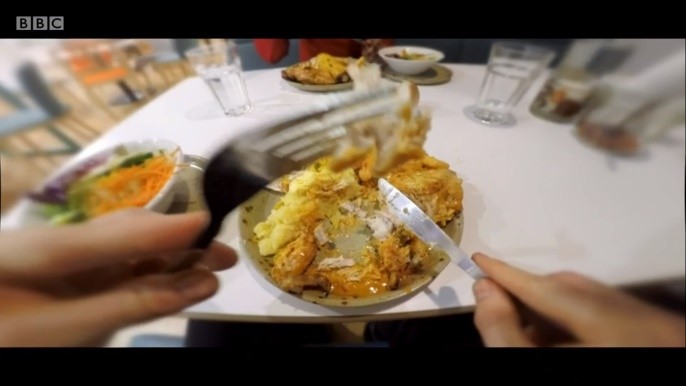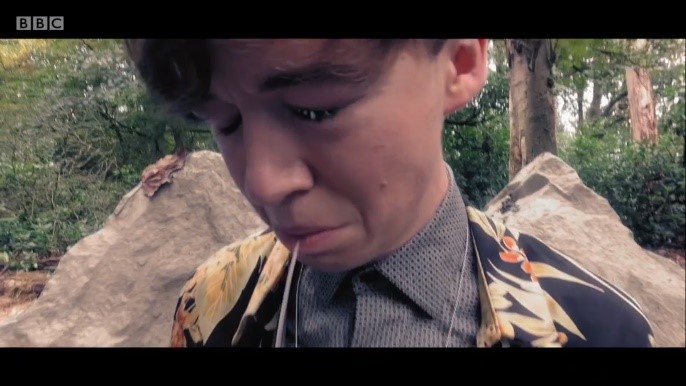What would the world be like if everybody was vegan? According to Simon Amstell’s vision of the future in Carnage, it’s a peaceful utopia in which the young vegans of tomorrow frolic in fields and enjoy food much more, knowing that nothing was taken from an animal, albeit one in which the older generations of ex-meat-eaters struggle to reconcile their past carnivorous tendencies with the new world order.
Amstell’s mockumentary is a speculative account of how this society of 2067 came into being, combining real life footage dating back to the 1940s with fictional future segments to tell the story of how we arrived at our present-day tastes for animal products and where a vegan-led movement would take us. In presenting this documentary from ‘the future’, Amstell attempts to show the banal grotesqueness of our omnivore ways and its potential future implications for ourselves and the planet.
The film parodies the style of documentary commonly found on television. It employs common tropes of this genre to tell its story: interviews with key figures involved in the rise of veganism; first hand footage from settings such as the ex-carnivores therapy group; historical re-enactments of everyday life in the past; the employment of social ‘experiments’. These fictionalised segments are given additional gravity by their combination with actual footage from the TV archives, and more distressing from undercover slaughterhouse reporting. These are seamed together in montages to create an uncomfortably conscious relation between the images of cooking and eating meat and the gruesome scenes of animals being killed and butchered.
But the film is also a comedy, and Amstell uses his background as a stand-up comedian to great effect in order to get his message across simply without resorting to the violently coercive tactics employed in many vegan films (e.g. Earthlings). As he explained in a 2017 interview with Mark Kermode for the BFI, “the intention was to make something kind of self-deprecating, and funny enough that you didn’t mind when a new bit of information was presented.”1 He often uses his dry voiceover to satirise the folly of humans’ attitudes towards animals: he ironically remarks about the release of the film Babe for example that “in 1995 taking your children to watch a likeable pig escape death, followed by a celebratory Happy Meal, was completely acceptable”, as an authentic advert for promotional Babe Happy Meals at McDonalds is shown, highlighting the double standards explicit in our attitudes towards what animals are acceptable to eat and which can be saved, and more significantly how we teach these attitudes to our own children.
In such a film as this, animal presences are very frequent, albeit brief, and come in various forms of representation: as both alive or dead, pet or meat, puppet or soft-toy. One of most interesting variants on this is the animal as performed by a human being: this is exhibited most explicitly in an ‘extract’ from a BBC broadcast of a hit musical from 2024 about the life of a dairy cow, played by a female human actress (Samantha Spiro) dressed in a silly costume and wearing cow ears (parodying shows like Cats). This is a fascinating example of the use of anthropomorphism to convey across to an audience the emotional distress of a cow caught within the dairy industry, one that takes away their male calves to be culled. She is lit by a high spotlight shining down on her upon the dark stage – the use of this harsh and confining light stresses the cold uncomfortable nature of cow rearing. The employment of the medium of musical theatre in this context amplifies the feelings of the central character to provoke more pathos, almost as much as it parodies this style for comic effect, as she sings excessively mournfully “Moo! He needs his mother too.” The lyrics of the song are similarly charged with strongly evocative imagery: at one point, the cow sings “What kind of animal rapes for milk?” The employment of so intense a verb amplifies the gravity of artificial insemination of cattle to the level of sexual abuse. The use of the term ‘animal’ meanwhile conveys dual meaning: on one level, questioning the civility of this procedure by dehumanising those who employ it; on another, signifying that no species but humans drinks the milk of other animals.
The film charts our transition from our current meat-eating to future plant-based diets, but the process isn’t quite so straightforward. In a segment of the documentary entitled as a ‘Historical Reconstruction’, we witness the struggle faced by two individuals during the so-called ‘Era of Confusion’. Here Amstell extents such struggles around giving up meat to their comically absurd yet plausible conclusions: for example, you could potentially give up meat, but “what if […] you legally bought a cat who refused to eat anything other than fish? Now you were killing 50 fish a month to keep one cat alive.” He further problematises this by contemplating that “you should never have bought [a cat] in the first place, because what right does one animal have to own another?” This reductio ad absurdum is exemplified in the behaviour of these people in the midst of a moral existential crisis. One sequence following this juxtaposes a low angle medium shot of a man staring down despairingly with a close up of the domestic cat he is looking at, who is stuck outside knocking at a door window. This moment exhibits Amstell’s hypothesis, particularly when he later mentions that “Many people felt it was best to let their pets starve and die”, as we watch the man walk away in shame, leaving the cat stuck bemused outside. This climax to the scene adds a grimly humorous edge, but also allows present-day audiences to consider the extended ramifications of the vegan moral lifestyle, and more broadly our relationships with animals. Indeed, the feline encounter in this scene echoes that described by Jacques Derrida in his 2002 essay The Animal That Therefore I Am (More to Follow), a phenomena described as “animalséance: the single, incomparable and original experience of the impropriety that would come from appearing in truth naked, in front of the insistent gaze of the animal, a benevolent or pitiless gaze, surprised or cognizant.”2
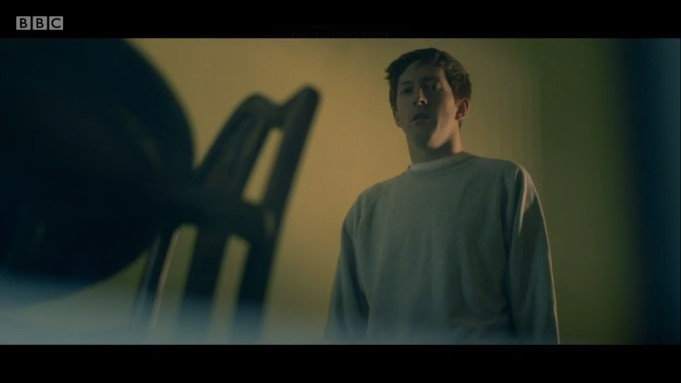
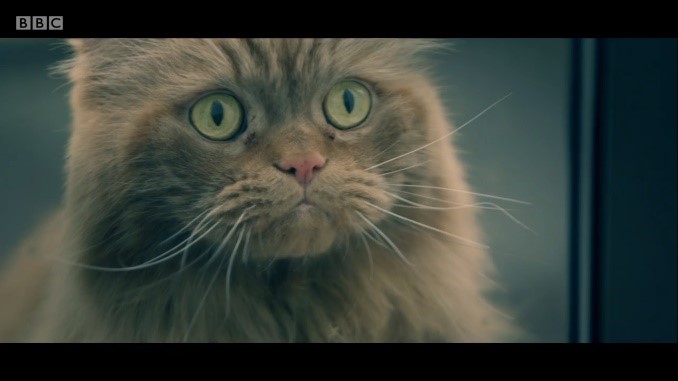
By the future of 2067, human relations towards animals have changed drastically. The youth of the period feel an affection for animals, and cannot begin to conceive that people used to kill them for food: one interviewee (Alex Lawther) towards the beginning of the film asks “Why would any one eat a baby? It’s just a little baby. A little baby lamb.” A sequence that marks their profound remove from attitudes of the ‘past’ shows the young people taking part in an experiment that “uses the latest multi-sensory VR technology” to transport them “back 50 years to a popular high street chicken restaurant” which, as Amstell wryly comments, served up “half a million deceased chickens a week.” The scene cuts between medium shots of the test group sitting cross-legged in a circle in the woods with wires stuck in their mouths and the POV footage from the virtual reality film, in which the plate of chicken takes up the entire centre of the frame, and remains in sharp focus as objects in the periphery and close to the camera are blurred, which not only creates the impression of human sight but also ensures the dead meat of the chicken never leaves our sight (or that of the young participants). The intensity of the scene is amplified as the cuts appear more suddenly and the camera zooms in more towards the painful grimacing expressions of the test subjects, as the footage from the VR shows a forkful of chicken rising towards the lense, and by association the mouth of the carnist from the past. What appears to us present day viewers as a typical scene from an ordinary dining experience is problematised through the use of cinematography and montage, and while the abject reactions of the future citizens of 2067 may appear comically extreme, it serves to highlight the barborous absurdity of eating dead animals and the progressive, albeit fragile, sensitivities of the vegan children of tomorrow. As one of the participants exclaims earnestly, “How can anyone just eat a bird?”
Fig 5 – POV fisheye shot of a plate of chicken and a forkful of chicken moving towards the camera; Fig 6 – close-up of one of the young participants grimacing painfully
In contrast to this, we also learn of the guilt felt by former omnivores in this plant-based society. As psychotherapist and former meat eater Dr Yasmin Vondenburgen (Linda Bassett) explains, for these older individuals in the future, it’s difficult to admit out loud that “I ate animals. I ate fish. I drank the milk from cows.” This shame from attempting to come to terms with their abusive relations to animals is exemplified in footage shot during one of her weekly support groups, which shows a group of elderly people participating in an exercise in which they asked to name a type of cheese they used to eat. As with the previous scene, their reactions seems unusually grave to our present day sensibilities, as each participant expresses an unusually pained expression as they struggle to confess to their food crimes, with one female participant running out crying after saying “Edam”. Yet Vondenburgen highlights earnestly the gravity of this scenario and the intense shame felt by the group members, as she explains in a later interview to camera: “We were all victims. Most of my patients were children at the time […] Our parents just did to us what their parents had done to them.” The employment of the rhetoric of abuse cycles emphasises the perpetuated nature of the shame the patients feel, whilst the reminder of the childhood of these people bridges the temporal disjunction between this speculative future and our own present day – our meat-fed children of today may well become the guilt-ridden elders of tomorrow.
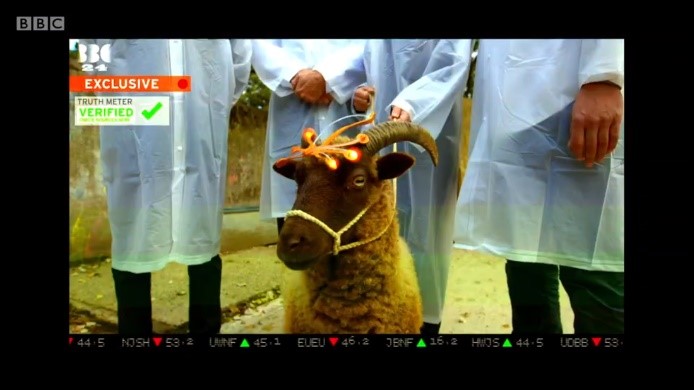
Fig 7 – close-up on ‘Lucy the sheep’ sporting pioneering animal thought-reading technology
A key aim of this mockumentary that it shares with most other vegan documentaries is to anthropomorphise the animals within the film – or as Amstell puts it in its introduction, to show “how meat became people” – in order to convince its audience that they should be given as much respect as human beings. A pivotal scene towards the end of the film exhibits “a machine that could read the general thoughts and feelings of other animals”, one which whimsically enough gives them the voice of Joanna Lumley. As Amstell explains, this future invention means that “everyone could see and hear that other animals like them had feelings”. While this device offers up hilarious moments where Lumley’s voice is used to dub a male cow’s discontent – “Why are you still trying to make me ejaculate?” – it also serves to easily convey the notion that all animals are sentient and feel emotions in the same way that humans do, especially since in essence humans are animals too.
In this vein the film also serves to problematise the anthropo-superiority of humans. This becomes most apparent in a horrifically tragic climax of the film, which describes the violent murder of the influential animal rights activist Troye King Jones (John Macmillan). As vegan intellectual Maude Polikoff (Lindsay Duncan) explains, the murderer “broke into Troye’s house and stabbed him to death… and then ate him.” The political assassination narrative here is uncomfortably extended to the point of cannibalism – in this case, people become meat. This is absurdly amplified by the black humour inherent when Polikoff says “We couldn’t even bury him, because he’d been eaten.” The entire practice of meat-eating is thus rendered particularly barbaric by association (whatever the animal is), because of the ridiculously desperate lengths the killer went to defend his carnism. The effect of this moment is reflected in the narrative, when Vodenburgen explains that “After that, very few people wanted to be seen as a carnist.”
Overall, the employment of humour in Amstell’s mockumentary helps ease its audience into its earnest discussion of animal rights issues. By using the future as a vantage point from which to satirise and critique our present-day attitudes towards animals, Carnage attempts to show us the grotesque and absurd reality behind consuming animal products, and the potential impact of our dietary habits upon the lives of future generations. In particular, by bestowing animals with a ‘voice’, Amstell confronts the anthropocentric human psyche to argue that they feel emotions just like we do. The future society of 2067 thereby becomes an irreverent blueprint for a progressive vegan movement, and how through enablement and encouragement, not coercion, animal rights activists might be able to move more people towards a plant-based diet.
Fig 8 – trailer for Carnage
Footnotes
- BFI, Simon Amstell on his vegan sci-fi Carnage: “If we keep eating animals it’s going to get awkward”, online video recording, YouTube, 29 March 2017 <https://www.youtube.com/watch?v=DMcli9vhM2I> [accessed 17 January 2019], 0:34-46
- Jacques Derrida, ‘The Animal That Therefore I Am (More to Follow)’, in The Animal That Therefore I Am, ed. by Marie-Louise Mallet, trans. by David Wills (New York: Fordham University Press, 2008), pp. 1-51 (p. 4). ACLS Humanities ebook
Further Reading
Amstell, Simon, dir., Carnage (BBC, 2017) <https://www.bbc.co.uk/iplayer/episode/p04sh6zg/simon-amstell-carnage> [accessed 20 January 2019]
BBC, ‘Simon Amstell: Carnage – Carnage: The Facts’, BBC, 2017 <https://www.bbc.co.uk/programmes/articles/VN3BnwnWKCytkfzhxL1BB4/carnage-the-facts> [accessed 20 January 2019]
Ewens, Hannah, ‘Simon Amstell On His New Vegan Mockumentary, ‘Carnage’’, VICE, 2017 <https://www.vice.com/en_uk/article/vvj7k3/simon-amstell-on-his-new-vegan-mockumentary-carnage> [accessed 20 January 2019]
Freeman, Carrie Packwood and Simon Tulloch, ‘Was Blind But Now I See: Animal Liberation Documentaries’ Deconstruction of Barriers to Witnessing Injustice’, in Screening Nature: Cinema Beyond the Human, ed. by Anat Pick and Guinevere Narraway (New York: Berghahn Books, 2013), pp. 110-126. ProQuest Ebook Central ebook
kermodeandmayo, Kermode Uncut: Carnage, online video recording, YouTube, 10 March 2017 <https://www.youtube.com/watch?v=Il9_WV8j6_o> [accessed 21 January 2019]
